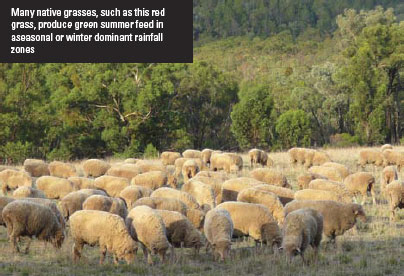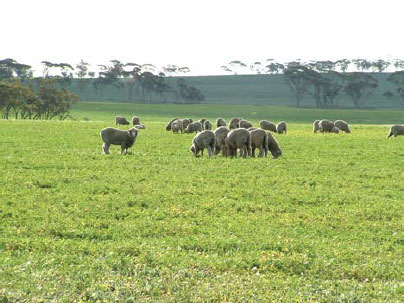 |
 |
Assess your pastures to determine if the existing species are limiting pasture growth and quality
|
 |
Weigh up the benefits, costs and risks of sowing new pastures and prepare a developmental budget before spending large amounts of capital |
|
 |
Introduction
Different land classes and production systems (eg, permanent pasture versus pastures in rotation with cropping) require different species mixtures. A practical way of combining soil and paddock information is presented as tool 6.1 in Healthy Soils. Use tool 6.1 to assess the most appropriate pasture system for each area of the farm.
If there is a reasonable base of desirable species present, it is always cheaper and easier to use the grazing management practices outlined in procedure 7.2 to strengthen your existing pastures, rather than sowing a new pasture.
The aim of this procedure is to help sheep producers establish a new pasture in paddocks where there are insufficient desirable species present. This will require greater intervention.
While some clovers or medics and
desirable annual grasses (eg, annual
ryegrass) can volunteer in pastures in
many regions if conditions are right,
They are unlikely to be as productive as
sowing a pasture mix well suited to the
soil and rainfall conditions.
Introducing new species and cultivars
can involve a large capital expenditure,
typically $150 – $300/ha, depending on
sowing method and inputs required. The
main reason for poor establishment of
new pastures is lack of preparation and
unsuitable species selection. It can also
be a risky exercise, particularly in regions
where introduced perennial grasses, and
even annual legumes, struggle to persist
due to harsh or highly variable climatic
conditions or soil.
The focus in this procedure is on
establishing and managing permanent
pastures. There are many different issues
to be considered in selecting, establishing
and managing pastures in cropping
rotations, such as control of pests,
diseases and herbicide resistant weeds
or N fixation for following crops. These
factors often influence pasture selection
and management more than the potential
for animal production.
Key decisions, critical actions and benchmarks
Assess your pastures to determine if the existing species are limiting pasture growth and quality. A number of pasture assessment techniques are described in tool 7.6.
- Identify desirable perennial grass plants (tool 7.6). If there are some perennial grasses present, you might be able to improve their size, vigour, density and growth rates to the extent that you may not need to sow more plants. As a ‘rule of thumb’, if you have 5–10 phalaris, cocksfoot or fescue plants/m2 or 10‑15 perennial ryegrass plants/m2 you have an opportunity to use grazing to improve the perennial content of the pasture
- Similar benchmarks probably also apply to native perennial grasses but, at this stage, there is no economic way to re-sow these pastures and therefore grazing management is the only option. Note: Replacing native species with introduced pastures is restricted by native vegetation protection legislation in some regions. Check with your regional natural resource management authority (see procedure 5.3 signposts in Protect Your Farm’s Natural Assets) before attempting to replace native pastures.
For sowing new pastures, the following three steps are critical to ensure the investment is profitable.
Ensure establishment succeeds the first time
Prepare for sowing at least 1-2 years before the proposed sowing date.
Choose species and cultivars that are well suited to the land class/soil conditions and the rainfall pattern/reliability, ie, tried and proven in your local area. There is a wealth of information on this topic. Sources relevant to different states/regions are listed in the signposts.
Ensure good weed control and an appropriate sowing method. A thorough weed control program in the 3-4 months prior to sowing is critical to success.
If an autumn sowing is planned, spray topping should be carried out in the previous spring to prevent seed-set.
Direct drilling (spray and sow) is a proven, reliable technique for establishing pastures for all regions but is especially suitable in the high rainfall/permanent pasture zone. In the wheat–sheep zone, undersowing can be effective in lowering the cost, although competition from the crop usually results in lower numbers of pasture species establishing per square metre. Refer to the signposts for more information on pasture establishment methods.
Ensure the desirable species persist
The longer a pasture lasts, the more
likely it is to be profitable. For longterm
perennial pastures, appropriate
grazing management and strategic use
of fertilisers (see signposts in procedures7.1 and 7.2) can help pastures persist
almost indefinitely in the high rainfall
zone (above 600mm of annual rainfall).
Different rules and expectations apply
to short-term pastures sown in rotation
with crops, but the benefits in livestock
production and grain yields still have to
outweigh the costs.
Short-term or special-purpose pastures
(e.g. cereals, brassica, chicory, plantain
or legumes) have a role in filling specific
feed gaps and for finishing lambs.
The short-term nature of many of
these pastures means that substantial
increases in livestock production per
hectare (higher stocking rate or heavier
lamb turn-off weights or savings in
supplementary feed) are required to make
sowing the pasture profitable.
Increase livestock production
Pasture introduction cannot increase returns by itself. The value has to come from turning off more wool or meat per hectare or, in fewer cases, by increasing the value of the product. In many cases, the investment in the extra animals needed to utilise the increase in pasture will be greater than the investment in the pasture itself. An additional investment in improved management skills may also help ensure a strong profit flow from an investment in pasture establishment.
Feed supply can be varied to meet animal demand by introducing new pasture species at critical times, increasing pasture growth as described in this module, or through better alignment of animal demand with pasture supply (see procedure 8.3 in Turn Pasture into Product).

Signposts  |
Read
Eight Steps to Successful Pasture Establishment: Visit: www.dpi.nsw.gov.au/agriculture/pastures-and-rangelands/establishment-mgmt/establishment/eight-steps
The MLA Pasture Health Kit: a field kit for producers to assess pasture health in the paddock. The kit can be ordered from MLA by:
The Graziers’ Guide to Pastures (2003): sowing and managing profitable pastures in the Southern Tablelands, Central Tablelands, Monaro and the Upper South West slopes of New South Wales. Download a free copy from Industry and Investment NSW website: www.dpi.nsw.gov.au/agriculture/pastures-and-rangelands/establishment-mgmt/grazing-management2/graziers-guide-pastures.
Perennial Pastures for Western Australia, 2007: covers all perennial options from
herbaceous legumes to temperate and sub-tropical grasses, herbs, fodder shrubs
and saltland pastures. Download the order form from the DAFWA website: http://researchlibrary.agric.wa.gov.au/bulletins/1/
Web-based sources of technical information on perennial pasture establishment for each state can be found by searching the following state agency websites:
EverGraze Fact Sheets: EverGraze is developing and testing new farming systems in different environments across the high rainfall zone of southern Australia. The target is to increase profits of sheep and cattle enterprises by up to 50% and at the same time improve water management, use of perennials, biodiversity and soil health. Download the following EverGraze Fact Sheets at:http://www.evergraze.com.au/fact-sheets.htm
- EverGraze Exchange – Grazing Management Systems Explained (588kb)
- EverGraze Action – Growing and Using Chicory on the East Coast (455kb)
- EverGraze Action – Growing and Using Chicory in WA (461kb)
- EverGraze Action – Growing and Using Lucerne (475kb)
- EverGraze Action – Growing and Using Kikuyu in WA (458kb)
- EverGraze Action – Grazing Phalaris for production and persistence (419kb)
- Evergraze Action – Productive, persistent Perennial Ryegrass (481kb)
- EverGraze Action – Growing and Using summer active Tall Fescue (542kb)
- EverGraze Action – Native pastures of the Eastern Namoi (2MB)
- EverGraze Action – Management of Native Pastures in Victoria (452kb)
- Also view the Evergraze tools section of the website.
A range of useful links can be found on the Pastures Australia pages of the GRDC website, by clicking this link.

View
Grassland Society of Southern Australia Inc: sheep producers can access this website to find a listing of currently available cultivars of grasses and legumes. The list includes details on growth pattern of the cultivar, preferred soil conditions, annual rainfall required and sowing rates. Visit: http://www.grasslands.org.au/
A-Z listing of pasture species and varieties: information on over sixty species of pasture – temperate and tropical legumes and grasses, pasture herbs and forage shrubs. Visit: http://www.dpi.nsw.gov.au/agriculture/pastures-and-rangelands/species-varieties
DAFWA Videos: information on establishment and management of sub-tropical pastures. Visit YouTube and search for DAFWA sub-tropical grasses.
Grassland Society of NSW Inc: Provide
information on a range of temperate and
tropical pasture species. Newsletters and
conference proceedings can be viewed
online at www.grasslandnsw.com.au
|
|